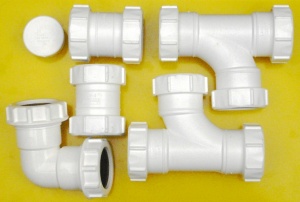Waste pipe
Pipe Sizes & Types
The (nominal) sizes of waste pipe used for domestic houses are
- 21.5mm
- 32mm (aka 1.25")
- 40mm (aka 1.5")
- 50mm (aka 2")
Uses of the sizes:
- 21.5mm - overflow pipe from cisterns, not used for sink waste
- 32mm - for basin or bidet (upto 3 can be connected to a 32mm pipe)
- 40mm - for kitchen sink, washing machine etc, can service several appliances
- 50mm - for many appliances & food waste disposal units
Larger sizes also exist, and are used in flats and large houses.
There are 2 types of pipe, solvent weldable and non-weld. For a given nominal size,
- solv weld pipes are all the same real size.
- non-weld pipes are fractionally bigger
- exact non-weld pipe size varies a bit between manufacturers
- Just to be helpful, all these pipe variations are described using exactly the same nominal size description.
- Solv weld pipe is for solv weld fittings
- Non-weld pipe is for pushfit fittings
- Compression fittings usually fit both types of pipe
If fittings are stiff, see the grease section further down (not on solv weld of course).
Fall
New pipework should have a fall of 18-90 mm/metre to comply with building regs part H. Pipework outside these figures has increased tendency to deposit solids, increasing risk of blockage.
Occasionally waste pipework is seen that flows uphill. Water isn't so keen on going upwards, and such arrangements tend to either not work or collect solids and be prone to blocking.
Types of fitting
Solvent weld
- small & slim
- relatively cheap fittings
- use solv weld pipe only, the other type won't fit or weld
- undoing a solvent weld is completely impossible, the plastic fuses together becoming one piece
- To fit, wipe the fitting and pipe clean, brush on pipe weld solvent, assemble the joint and let it set. If the pipe isn't clean, use a scourer first
- Solv weld piping sometimes lacks access points, as no joints can be undone. Where access is needed, an access point can be included (or even a compression or pushfit tee, if preferred).
Compression
- bulkier
- more money
- generally these fit all variations of a given nominal size of pipe
- undoable
- reusable if the rubber rings are ok (replacements are available)
- check its watertight after fitting, as its possible for the rubber sealing ring to sit wrong and allow leakage
Pushfit
- Quick & easy to use
- Some are easy to remove
- Generally won't fit solv weld pipe
- Joints can be pulled apart, so proper pipe support is necessary.
Compliance
New pipework must be building regs compliant at time of fitting. Old pipework need not legally meet any building regulations, current or past, and upgrades of such pipework are at the discretion of the householder. A lot of non-compliant pipework works fine in practice.
Blockage prevention
- Correct fall
- Straight as possible runs, minimise the of use right angle joints
- Enough access points to enable rodding the full length of the pipe.
- Where space permits, a swept bend is better than a sharp right angle
- Avoid putting any cooking fat or solids down the sink. Molten fat causes lots of blockages.
Badly designed pipework with very poor flow is occasionally seen. With this, an occasional flush can help reduce solids build up, lessening the risk of blockage. This is easily done by eg filling the sink at the beginning of the pipe run to the brim, and letting it flush the pipe.
Impending blockages are easier to clear than a blocked pipe, and can be spotted in 3 ways:
- sink drains very slowly
- outflow of pipework very slow (visible on old open drain systems)
- Trickling sound of pipework continues awhile after the sink etc is empty
Unblocking
Cutting
The main ways to cut plastic waste pipe are:
- Plastic pipe cutters - these look like giant secateurs
- Saw - most types will do it.
Sawn ends need the outer & inner burr trimming off with a knife.
Clips
Plastic pipes sag under the load of water easily, and should be clipped to the wall. Failure to do so results in sag, increased risk of blockage and tendency for the pipe to pull out of pushfit or compression fittings.
Different types and brands of pipe clips have differing pipe to wall spacing.
If you're missing a clip somewhere and the pipework will be out of sight, a screw into the wall can be used to support it.
Grease
Grease on rubber rings in fittings isn't essential, you can assemble pushfit without, but it makes it much easier, especially on larger stuff like WC connectors.
Grease makes the assembly simpler, you're less likely to dislodge a sealing ring on a pushfit, it can also improve the seal in the case of minor scratches on the pipe, and universal fittings do up tighter and more easily with a little grease. Silicone sprays can be faster to apply on large fittings.
Its important to use silicone rather than other types of grease so as not to attack the rubber of the seal.
Some of the pushfit makers sell branded tubs of it right beside the fittings. Makers like Polypipe recommend its use in assembly. See (3) in opening section here
CPC sell small 50g tubes of silcone grease that last for ages. Much cheaper than the pipe makers branded ones. One of these in the plumbing kit will last for years. (Very good for stopping leaks on rubber seals on cars as well I find - a gentle wipe over will often stop water or wind ingress. Also for getting tight sleeves over wires and cables etc.)
